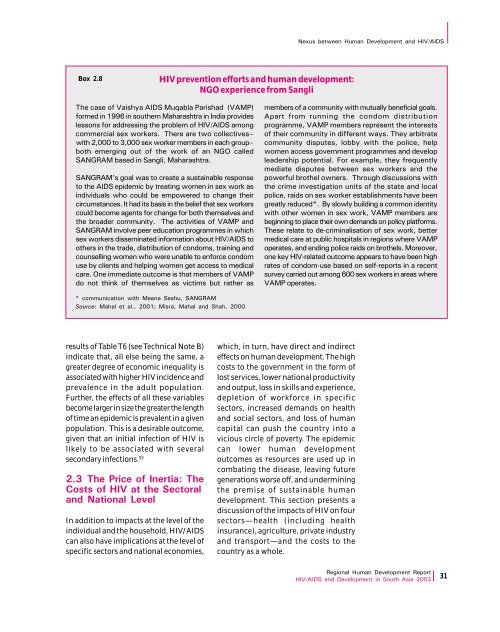Download Report - UNDP Asia-Pacific Regional Centre - United ...
Download Report - UNDP Asia-Pacific Regional Centre - United ...
Download Report - UNDP Asia-Pacific Regional Centre - United ...
Create successful ePaper yourself
Turn your PDF publications into a flip-book with our unique Google optimized e-Paper software.
Nexus between Human Development and HIV/AIDSBox 2.8HIV prevention efforts and human development:NGO experience from SangliThe case of Vaishya AIDS Muqabla Parishad (VAMP)formed in 1996 in southern Maharashtra in India provideslessons for addressing the problem of HIV/AIDS amongcommercial sex workers. There are two collectives–with 2,000 to 3,000 sex worker members in each group–both emerging out of the work of an NGO calledSANGRAM based in Sangli, Maharashtra.SANGRAM’s goal was to create a sustainable responseto the AIDS epidemic by treating women in sex work asindividuals who could be empowered to change theircircumstances. It had its basis in the belief that sex workerscould become agents for change for both themselves andthe broader community. The activities of VAMP andSANGRAM involve peer education programmes in whichsex workers disseminated information about HIV/AIDS toothers in the trade, distribution of condoms, training andcounselling women who were unable to enforce condomuse by clients and helping women get access to medicalcare. One immediate outcome is that members of VAMPdo not think of themselves as victims but rather asmembers of a community with mutually beneficial goals.Apart from running the condom distributionprogramme, VAMP members represent the interestsof their community in different ways. They arbitratecommunity disputes, lobby with the police, helpwomen access government programmes and developleadership potential. or example, they frequentlymediate disputes between sex workers and thepowerful brothel owners. Through discussions withthe crime investigation units of the state and localpolice, raids on sex worker establishments have beengreatly reduced*. By slowly building a common identitywith other women in sex work, VAMP members arebeginning to place their own demands on policy platforms.These relate to de-criminalisation of sex work, bettermedical care at public hospitals in regions where VAMPoperates, and ending police raids on brothels. Moreover,one key HIV-related outcome appears to have been highrates of condom-use based on self-reports in a recentsurvey carried out among 600 sex workers in areas whereVAMP operates.* communication with Meena Seshu, SANGRAMSource: Mahal et al., 2001; Misra, Mahal and Shah, 2000results of Table T6 (see Technical Note B)indicate that, all else being the same, agreater degree of economic inequality isassociated with higher HIV incidence andprevalence in the adult population.Further, the effects of all these variablesbecome larger in size the greater the lengthof time an epidemic is prevalent in a givenpopulation. This is a desirable outcome,given that an initial infection of HIV islikely to be associated with severalsecondary infections. 552.3 The Price of Inertia: TheCosts of HIV at the Sectoraland National LevelIn addition to impacts at the level of theindividual and the household, HIV/AIDScan also have implications at the level ofspecific sectors and national economies,which, in turn, have direct and indirecteffects on human development. The highcosts to the government in the form oflost services, lower national productivityand output, loss in skills and experience,depletion of workforce in specificsectors, increased demands on healthand social sectors, and loss of humancapital can push the country into avicious circle of poverty. The epidemiccan lower human developmentoutcomes as resources are used up incombating the disease, leaving futuregenerations worse off, and underminingthe premise of sustainable humandevelopment. This section presents adiscussion of the impacts of HIV on foursectors—health (including healthinsurance), agriculture, private industryand transport—and the costs to thecountry as a whole.<strong>Regional</strong> Human Development <strong>Report</strong>HIV/AIDS and Development in South <strong>Asia</strong> 2003 31
















